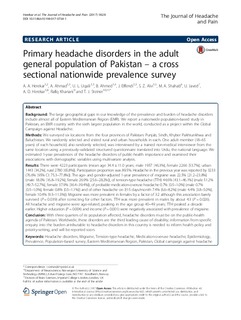| dc.contributor.author | Herekar, AA | |
| dc.contributor.author | Ahmad, A | |
| dc.contributor.author | Uqaili, UL | |
| dc.contributor.author | Ahmed, B | |
| dc.contributor.author | Effendi, J | |
| dc.contributor.author | Alvi, SZ | |
| dc.contributor.author | Shahab, MA | |
| dc.contributor.author | Javed, U | |
| dc.contributor.author | Herekar, AD | |
| dc.contributor.author | Khanani, Rafiq | |
| dc.contributor.author | Steiner, Timothy J. | |
| dc.date.accessioned | 2018-02-09T11:46:52Z | |
| dc.date.available | 2018-02-09T11:46:52Z | |
| dc.date.created | 2017-11-14T10:47:14Z | |
| dc.date.issued | 2017 | |
| dc.identifier.citation | The Journal of Headache and Pain. 2017, 18:28. | nb_NO |
| dc.identifier.issn | 1129-2369 | |
| dc.identifier.uri | http://hdl.handle.net/11250/2483701 | |
| dc.description.abstract | Background
The large geographical gaps in our knowledge of the prevalence and burden of headache disorders include almost all of Eastern Mediterranean Region (EMR). We report a nationwide population-based study in Pakistan, an EMR country with the sixth largest population in the world, conducted as a project within the Global Campaign against Headache.
Methods
We surveyed six locations from the four provinces of Pakistan: Punjab, Sindh, Khyber Pakhtunkhwa and Baluchistan. We randomly selected and visited rural and urban households in each. One adult member (18–65 years) of each household, also randomly selected, was interviewed by a trained non-medical interviewer from the same location using a previously-validated structured questionnaire translated into Urdu, the national language. We estimated 1-year prevalences of the headache disorders of public-health importance and examined their associations with demographic variables using multivariate analysis.
Results
There were 4223 participants (mean age 34.4 ± 11.0 years; male 1957 [46.3%], female 2266 [53.7%]; urban 1443 [34.2%], rural 2780 [65.8%]). Participation proportion was 89.5%. Headache in the previous year was reported by 3233 (76.6% [95% CI: 75.3–77.8%]). The age- and gender-adjusted 1-year prevalence of migraine was 22.5% [21.2–23.8%] (male 18.0% [16.8–19.2%], female 26.9% [25.6–28.2%]), of tension-type headache (TTH) 44.6% [43.1–46.1%] (male 51.2% [49.7–52.7%], female 37.9% [36.4–39.4%]), of probable medication-overuse headache 0.7% [0.5–1.0%] (male 0.7% [0.5–1.0%], female 0.8% [0.5–1.1%]) and of other headache on ≥15 days/month 7.4% [6.6–8.2%] (male 4.4% [3.8–5.0%], female 10.4% [9.5–11.3%]). Migraine was more prevalent in females by a factor of 3:2 although this association barely survived (P = 0.039) after correcting for other factors. TTH was more prevalent in males by about 4:3 (P = 0.026). All headache and migraine were age-related, peaking in the age group 40–49 years; TTH peaked a decade earlier. Higher education (P = 0.004) and income (P = 0.001) were negatively associated with prevalence of migraine.
Conclusion
With three quarters of its population affected, headache disorders must be on the public-health agenda of Pakistan. Worldwide, these disorders are the third leading cause of disability; information from specific enquiry into the burden attributable to headache disorders in this country is needed to inform health policy and priority-setting, and will be reported soon.
Keywords | nb_NO |
| dc.language.iso | eng | nb_NO |
| dc.publisher | SpringerOpen | nb_NO |
| dc.rights | Navngivelse 4.0 Internasjonal | * |
| dc.rights.uri | http://creativecommons.org/licenses/by/4.0/deed.no | * |
| dc.title | Primary headache disorders in the adult general population of Pakistan - a cross sectional nationwide prevalence survey | nb_NO |
| dc.type | Journal article | nb_NO |
| dc.type | Peer reviewed | nb_NO |
| dc.description.version | publishedVersion | nb_NO |
| dc.source.volume | 18 | nb_NO |
| dc.source.journal | The Journal of Headache and Pain | nb_NO |
| dc.source.issue | 1 | nb_NO |
| dc.identifier.doi | 10.1186/s10194-017-0734-1 | |
| dc.identifier.cristin | 1513834 | |
| dc.description.localcode | © The Author(s). 2017 Open Access This article is distributed under the terms of the Creative Commons Attribution 4.0 International License (http://creativecommons.org/licenses/by/4.0/), which permits unrestricted use, distribution, and reproduction in any medium, provided you give appropriate credit to the original author(s) and the source, provide a link to the Creative Commons license, and indicate if changes were made. | nb_NO |
| cristin.unitcode | 194,65,30,0 | |
| cristin.unitname | Institutt for nevromedisin og bevegelsesvitenskap | |
| cristin.ispublished | true | |
| cristin.fulltext | original | |
| cristin.qualitycode | 1 | |

